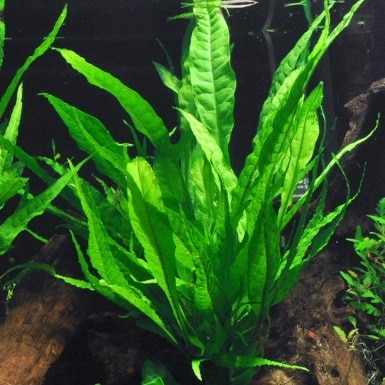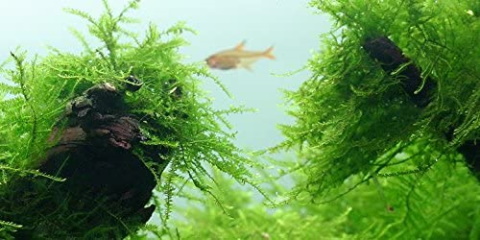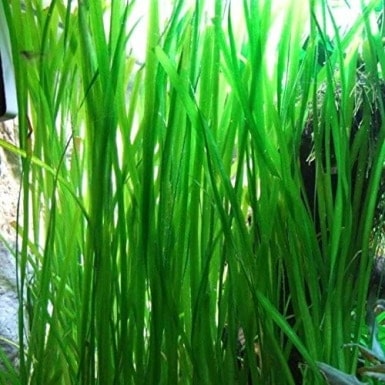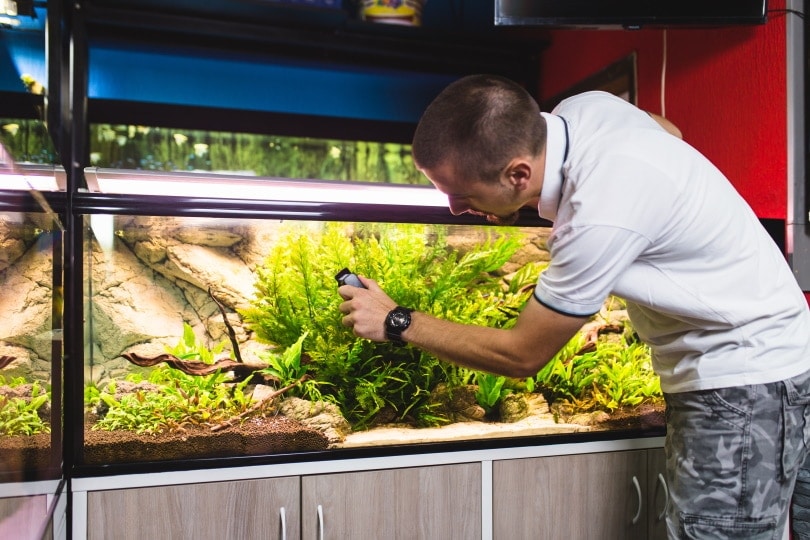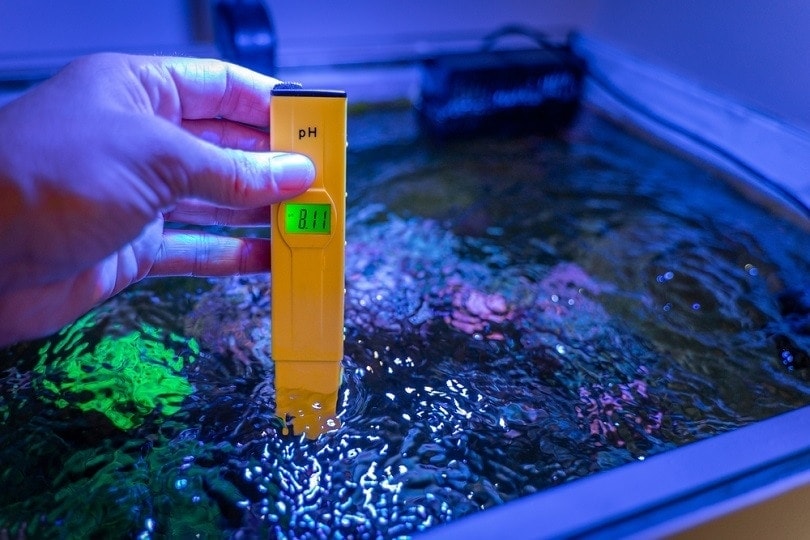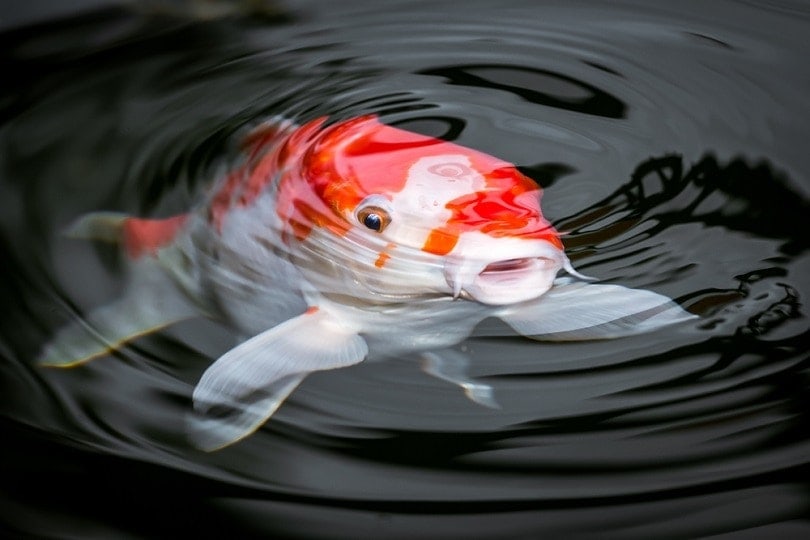6 Best Live Plants for Axolotls – 2024 Reviews & Top Picks

Updated on
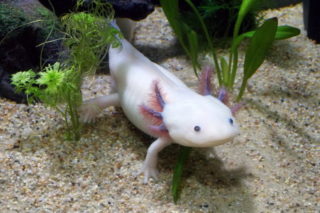
Axolotls are some unique little creatures, no doubt. This mix between a fish and a salamander is often a fan favorite among aquarium hobbyists due to their one-of-a-kind shape and coloration.
Here, we are big fans of putting live plants in any aquarium not only because they look nice, but because they also offer a variety of benefits for tanks. Let’s get right to it and figure out what the best live plants for axolotls are!
A Quick Comparison of our Favorites in 2024
| Rating | Image | Product | Details | |
|---|---|---|---|---|

|
Java Fern |
|
Check Price | |

|
Java Moss |
|
Check Price | |

|
Vallisneria |
|
Check Price | |

|
Dwarf Hairgrass |
|
Check Price | |

|
Anubias Nana |
|
Check Price |
The 6 Best Live Plants for Axolotls
Here we have six different plants, all of which are considered safe for axolotls. This means that they are not tall or sturdy enough to climb up to the rim of the tank.
It also means that they are safe to eat and non-toxic towards axolotls and cannot cause injury in any other way. Let’s take a look at what we consider to be the six best options for Axolotls.
1. Java Fern
| Care Level: | Easy |
| Light: | Low to moderate |
| Substrate: | Driftwood, porous rock |
| Goldfish Proof Score: | 99% |
| Water Purifying Score: | 35% |
- Large leaf size provides shelter
- Soft leaves pose no injury risk
- Thrive in low to moderate lighting
- Grow well in cool water
- Easy to grow
- Java Fern (12 – 14 inches)
- Narrow Leaf Java Fern (10 – 12 inches)
- Windelov/Lace Java Fern (7 – 8 inches)
- Trident Java Fern (8 – 10 inches)
- Needle Leaf Java Fern (5 – 6 inches)
- Petite Java Fern (3 – 4 inches)
- Philippine Java Fern (4 – 12 inches)
- Latifolia/Undulata Java Fern (8 – 12 inches)
The java fern is always a go to option for axolotl tanks. For one, these plants have fairly broad leaves which have a very nice bright green color. Those broad leaves can help provide your axolotl with a good hiding spot underneath them. The leaves are also very fine and soft, so there is no risk of injury.
Moreover, although your axolotl might try and take a bite out of your java fern, it’s not poisonous to them, so there’s that.
Although the leaves of this plant can grow up to 10 inches high, they are not sturdy or tall enough to facilitate an axolotl escape. This plant can survive in sand, although attaching it to something like driftwood works fine too.
Due to its size and relatively slow growth rate, it makes for a good background or middle-ground plant in axolotl tanks. Furthermore, a java fern can survive in fairly cool waters and they don’t need much light either, making them rather perfect for axolotl tanks, not to mention that this plant is very beginner friendly too.
2. Java Moss
| Care Level: | Easy |
| Light: | Low to high |
| Substrate: | Driftwood, porous rock, sand, gravel |
| Goldfish Proof Score: | 80% |
| Water Purifying Score: | 75% |
- Easy to care for
- Grows well in low lighting
- Grows well in cool water
- Great for water oxygenation
- Creates walking surface that allows for grip
Java moss is another fan favorite for axolotl tanks. For one, java moss is very hardy, resilient, and can survive in a variety of water conditions. Yes, this includes a dim and cool axolotl tank. Moreover, java moss is the perfect kind of aquarium plant to tie down to some rocks or driftwood. Once tied down, it will stay in place and grow.
Java moss is a carpeting plant that only grows a couple inches tall, but will grow outwards in width exponentially, thus forming a carpet wherever those roots can take cold. It’s nice because it doesn’t require too much maintenance at all, and it makes for a good foreground, middle-ground, and background plant, or even to make a carpet from one side of the tank to the other.
This can help create a very soft surface for your axolotl to walk and rest on, plus lots of food can get trapped in the java moss carpet, thus offering your axolotl a big buffet to scavenge food in. Sure, the axolotl might take a bite out of the java moss, but it’s not poisonous or harmful to them. It’s also a good plant in terms of filtering the water and producing oxygen, too.
3. Vallisneria
| Care Level: | Easy |
| Light: | Moderate to high |
| Substrate: | Any |
| Goldfish Proof Score: | 99% |
| Water Purifying Score: | 80% |
- Creates hiding places
- Minimal maintenance and pruning in low light
- Great background plant
- Hardy
- Can be grown on hard surfaces
- Jungle Vallisneria (24–72 inches)
- Jungle Vallisneria Red (18–72 inches)
- Vallisneria Spiralis (12–14 inches)
- Corkscrew Vallisneria (12–24 inches)
- Vallisneria Gigantea/Australis (20–30 inches)
- Vallisneria Asiatica (24–36 inches)
- Vallisneria Nana (18–20 inches)
- Vallisneria Tortifolia (8–10 inches)
- Vallisneria Natans (20–30 inches)
Yes, Vallisneria sounds very fancy and technical, but it’s really not. When it comes down to it, Vallisneria is more or less like underwater grass, kind of like cat grass. It features very slim and slender, long green leaves, which are definitely not sturdy enough for an axolotl to climb. Now, it can grow to 2 feet in length, but it’s still not sturdy enough to climb. It does have a relatively fast growth rate, so you will need to trim it often.
The rhizomes of the Vallisneria are perfect for attaching to rocks or driftwood with some fishing line. This plant will do just fine in the cool and low light conditions that axolotls prefer, which is good in terms of maintenance because cool temperatures and low light cause this plant to grow much slower, thus reducing the need for maintenance.
Vallisneria will provide your axolotls with some grass to run through and explore, as well as to hide within for some privacy. If they take a bite out of it, which they probably will, at least it is not poisonous. Plus, it grows more than fast enough to be relatively unaffected by a curious and hungry axolotl. It does make for an excellent background plant to make a big wall of green.
4. Dwarf Hairgrass

| Care Level: | Moderate |
| Light: | Moderate to high |
| Substrate: | Aquasoil, sand, gravel |
| Goldfish Proof Score: | 25% |
| Water Purifying Score: | 60% |
- Creates walking surface that allows for grip
- Thrives in cool water
- Hardy
- Collects food for scavenging
- Minimal maintenance and pruning in low light
This is another rather perfect option for axolotl tanks. Hairgrass is very hardy and resilient. In can survive in a diverse array of water conditions, and yes, this includes the cool and lowly lit tanks of axolotls. Moreover, while you can definitely plant this stuff in gravel, it’s also perfect for tying down to some rocks or driftwood, and it can even survive in sand substrate (although it’s not ideal). Simply put, this stuff can survive in virtually any and all axolotl tanks.
Hairgrass does not grow very tall (a few inches at most), making it a great middle-ground and foreground plant. It’s definitely not tall or sturdy enough to climb and facilitate an attempt at escape.
This stuff grows outwards more or less, but even them, its growth rate is not very high, especially in cool and low light conditions. Sure, it might create a carpet eventually, especially if you plant a few bunches close to each other, but once again, it does have a slow growth rate.
Also, hairgrass can help provide your axolotl with some small hiding spaces, food can get stuck in the grass thus making it great for foraging, and if your axolotl takes a bite out of it, it’s not poisonous to them either. In every way imaginable, hairgrass makes for a great live plant for axolotl tanks.
5. Anubias Nana

| Care Level: | Easy |
| Light: | Low to moderate |
| Substrate: | Driftwood, rocks, sand, aquasoil, gravel |
| Goldfish Proof Score: | 97% |
| Water Purifying Score: | 30% |
- Easy to care for
- Can be grown on hard surfaces
- Thrives in low light
- Great for water oxygenation
A really convenient thing about the Anubias Nana is that it can grow in virtually any and all substrates and conditions. This is the kind of plant that can be attached to branches, rocks, and driftwood, plus it can also be planted in gravel or sand if need be. Moreover, it will do just fine in relatively cool waters with low light. It’s a super hardy plant that’s almost harder to kill than it is to keep it alive.
The Anubias Nana grows to only 5 inches in height at the very most, which means that it’s not tall enough for an axolotl to climb. On that same note, the broad and round dark green leaves, while they look very nice, are not thick or sturdy enough for axolotls to climb.
These large and round leaves also provide some good hiding spots for axolotls, and although axolotls are not known to be fans of eating this stuff, even if they do try, it’s not poisonous to them.
The Anubias Nana makes for a really nice midground or background plant, and it can be used as a foreground plant in larger tanks too. This plant also excels at water oxygenation and filtration.
6. Hornwort
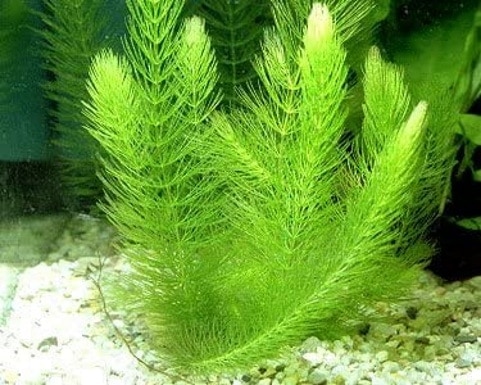
| Care Level: | Easy |
| Light: | Moderate |
| Substrate: | Any, none |
| Goldfish Proof Score: | 99% |
| Water Purifying Score: | 100% |
- Easy to care for
- Can be floated or planted in substrate
- Hardy
- Excellent for water purity
The last on the list has to be hornwort, which can grow up to a foot in height, making it a great background plant. It does grow pretty fast, especially with lots of light and warm water. However, it can also survive just fine in the cool and dim conditions that axolotls prefer, and when in these conditions, hornwort won’t grow nearly as fast.
Also, don’t worry because although it gets tall, the stems are not thick enough to support the weight of an axolotl, so it won’t be able to climb it.
Hornwort is a good option for axolotl tanks because it’s very soft and won’t injure them, it’s not poisonous if ingested, and it also makes for a great net that catches all sorts of food and debris for axolotls to eat.
Hornwort also does a fantastic job with water filtration and oxygenation.
Considerations When Buying Plants for Axolotl Tanks
Lighting Requirements
One thing you need to remember about axolotl tanks is that these creatures like the water to be relatively cool, plus they like low light conditions too. Therefore, any plant you want to get for an axolotl tank needs to be able to survive in cooler temperatures and low lighting.
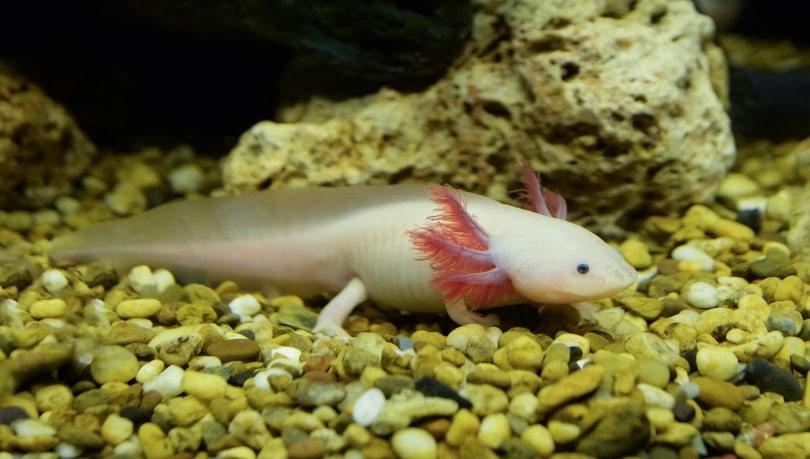
They Climb
On a side note, axolotls are great climbers, so you don’t want to put any really tall plants into the tank which are sturdy enough for the axolotls to climb. Chances are that they will climb it and jump out of the tank if they can.
Axolotl Sensitivity
Finally, axolotls, due to their very sensitive toes and feet, should not have gravel as substrate in their tanks. In other words, they need sand or some sort of tile.
This means that any plant which requires gravel substrate is a big no-no for axolotl tanks. You need plants that can be tied to rocks or driftwood, plants that can survive when rooted in sand, or floating plants.
Are Moss Balls Safe for Axolotls?
Yes, moss balls are safe to put in an axolotl tank, as long as the moss balls are larger than the axolotl’s head. As mentioned several times now, axolotls will eat mostly anything, and this includes moss balls that it can fit into its mouth.
Moss balls, while not inherently poisonous, but if enough moss is swallowed, it can cause some issues. An axolotl may choke or suffocate on a small moss ball, and it could cause digestion issues and blockages.
So, go ahead and put moss balls in the axolotl tank, but just ensure that they are of a good size.

Is Duckweed Safe for Axolotls?
Technically speaking, duckweed is fine for axolotl tanks. It is not poisonous if they eat it, and if it happens to block out a bit of light, that’s not much of an issue for axolotls either.
However, duckweed grows super fast and multiplies like nothing else, and those long roots can get everywhere. It’s not the best aquarium plant simply due to the fact that it grows like, well, a weed.
Do Axolotls Need Live Plants?
The fact of the matter is that every fish or salamander you have in an aquarium can benefit from having live plants in the tank. While an axolotl does not need live plants 100%, they are certainly beneficial in a number of ways.
Let’s take a quick look at why you want to strongly consider adding some live plants to your axolotl tank.
- First off, axolotls live in some fairly heavily vegetated conditions in the wild. In other words, adding live plants to an axolotl tank can really make them feel at home.
- Axolotls have very sensitive toes and feet, plus they often like to rest on soft surfaces. A good carpeting plant or something similar can help provide them with the soft surface they need.
- Axolotls can be quite skittish and often like to have privacy. Some leafy plants can help provide this privacy.
- Live aquarium plants also come with some other big benefits, mainly that they help produce oxygen in the tank, plus they help filter out contaminants too.
- There is also the fact that live plants make your tank look visually better.
Do Axolotls Eat Plants?
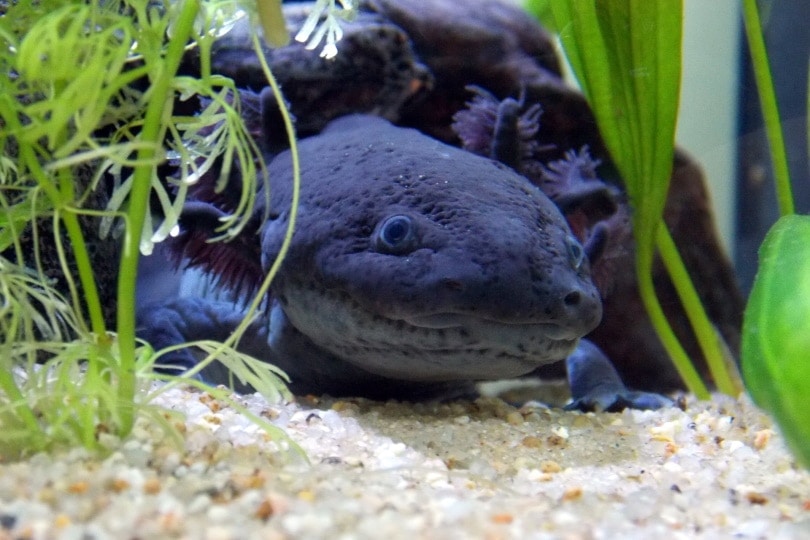
Axolotls can be a bit of a pain in the neck in this regard, as they will try to munch on virtually any and all aquarium plants. Now, sometimes they may actually eat the plants if they feel like it, or sometimes they may just chew on some leaves and spit them back out.
Moreover, if there is anything which an axolotl deems worthy of eating that is handing out on the plants, such as shrimp, snails, and other small crustaceans, it might get a mouthful of plant while aiming for the food.
In other words, axolotls are very clumsy and voracious eaters and will often get a mouthful of plants or substrate when aiming to devour some kind of food.
Avoiding having an axolotl munch on your plants is not going to happen. At once point or another, probably sooner than later, your axolotl is going to take some bites out of your live aquarium plants. Therefore, you need to get live plants that are not toxic to your axolotls.
Conclusion
As long as you have some nice aquarium plants that axolotls can eat without cause for worry, can survive in cool waters and with little light, and are not tall and sturdy enough for axolotls to climb to the rim of the aquarium, you should be fine with whatever you choose.
Remember, live plants do bring a lot of benefits to aquariums, so it is best to have some in there with your axolotls.
Featured Image Credit: Tinwe, Pixabay




